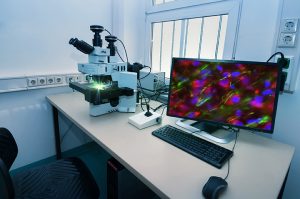Fluorescence microscopy is widely used in analytical and biotechnology applications due to its high sensitivity, specificity, and simplicity. Fluorescence occurs when a molecule absorbs light within its excitation band and emits light at a longer wavelength within its emission band.
Fluorescence microscopes employ optical fluorescence filters to selectively transmit specific wavelengths of light while blocking others. This selective filtering enhances image quality and minimizes specimen damage — both critical for accurate and repeatable observations.
But what are fluorescence filters?

A common question among researchers is: What are fluorescence filters, and how do they work in microscopy?
In essence, fluorescence filters are optical components that control which wavelengths of light are reflected or transmitted through a microscope system. They allow researchers to isolate and observe specific fluorescent signals that would otherwise be invisible under normal illumination.
A fluorescence microscope uses these filters to transmit light of selected wavelengths through the optical path, enabling detailed visualization of microscopic features. By isolating excitation and emission wavelengths, the filters make it possible to detect specific structures or molecules tagged with fluorescent dyes.
In most modern microscopes, fluorescence filters are integrated into a filter cube or filter block, which houses the key filtering elements necessary for epifluorescence microscopy.
The primary filtering elements in a fluorescence microscope consist of three optical filters, typically mounted within a filter cube or slide:
In contemporary fluorescence microscopes, these filters are typically interference filters, providing high precision and wavelength selectivity.
When fluorescent materials are illuminated by ultraviolet or visible light, they emit fluorescence. The excitation filter—also known as the exciter—selects specific wavelengths of light from the illuminator that are required to excite the fluorophore within the specimen.
Historically, excitation filters were short-pass types, but modern systems primarily use band-pass filters. These transmit only the wavelengths that correspond to the absorption band of the target fluorophore.
The transmission efficiency of the excitation filter determines the brightness of the resulting image. To produce bright, well-illuminated images, excitation filters should generally achieve at least 40% transmission at the desired wavelength.
Also known as the barrier filter or emitter, the emission filter blocks unwanted light outside the emission band of the fluorophore. It ensures that only the light emitted by the fluorophore passes through to the detector or eyepiece, effectively eliminating background noise and enhancing contrast.
Emission filters may be long-pass or band-pass, depending on the desired emission spectrum. By blocking stray and scattered light, these filters create a dark background, allowing the fluorescent signal to appear bright and distinct.
Emission filters vary in shape, size, and material composition—commonly made of plastic, glass, or metal-coated substrates. They are typically fixed components, meaning they require minimal maintenance and provide long-term reliability within the microscope system.
The dichroic beamsplitter, or dichroic mirror, is an edge filter that selectively reflects and transmits light based on wavelength. Positioned at a 45° angle of incidence, it reflects shorter excitation wavelengths toward the specimen while allowing longer emission wavelengths from the fluorophore to pass through to the detector.
This design enables efficient separation of excitation and emission light, a crucial function for high-quality fluorescence imaging. Dichroic mirrors are also used to combine or separate multiple light colors for multi-fluorophore imaging systems.

Fluorescence microscopy depends on precise light control. Modern instruments use interference filters—rather than simple glass lenses—to manage illumination and detection with high accuracy.
Filters serve several important functions:
By combining excitation and emission filters, fluorescence microscopes can detect multiple fluorescent dyes in rapid succession with high precision — a key advantage in multi-channel imaging.
For convenience and precision, modern microscopes often use fluorescence filter cubes, which house the excitation filter, dichroic beamsplitter, and emission filter in a single compact assembly.
Here’s how the optical path typically works:
These filter cubes simplify workflow by allowing researchers to easily switch between fluorophores or store pre-configured filter sets without repeatedly adjusting individual components.
Different manufacturers use unique naming conventions for optical filters. Understanding these can simplify the selection process:
Being familiar with these abbreviations ensures accurate selection and compatibility with existing optical systems.
Fluorescence microscopy remains an essential technique in biological and material sciences. A critical aspect of achieving accurate results lies in ensuring the sample receives the correct illumination through well-designed optical filters.
High-quality filters enhance image clarity, improve contrast, and protect delicate specimens from photodamage. Selecting the right combination of excitation, dichroic, and emission filters ensures optimal performance and reliability in fluorescence imaging.
If you’re looking for high-quality optical components, we manufacture precision-engineered, cost-effective solutions for the photonics and microscopy industries.
Contact us today to discuss your optical engineering requirements.